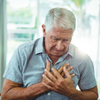
Heart and vascular services
The body's cardiovascular, or circulatory system, is made of the heart, blood, and blood vessels (arteries and veins).
Heart and vascular services refers to the branch of medicine that focuses on the cardiovascular system.

The heart's main job is to pump oxygen-rich blood to the body after it pumps oxygen-poor blood to the lungs. It normally does this 60 to 100 times a minute, 24 hours a day.
The heart is made of four chambers:
- The right atrium receives oxygen-poor blood from the body. That blood then flows into the right ventricle, which pumps it to the lungs.
- The left atrium receives oxygen-rich blood from the lungs. From there, the blood flows into the left ventricle, which pumps blood out of the heart to the rest of the body.
Together, the arteries and veins are referred to as the vascular system. In general, arteries carry blood away from the heart and veins carry blood back to the heart.
The cardiovascular system delivers oxygen, nutrients, hormones, and other important substances to cells and organs in the body. It plays an important role in helping the body meet the demands of activity, exercise, and stress. It also helps maintain body temperature, among other things.
CARDIOVASCULAR MEDICINE
Cardiovascular medicine refers to the branch of health care that specializes in the treatment of diseases or conditions dealing with the heart and vascular systems.
Common disorders include:
- Abdominal aortic aneurysm
- Congenital heart defects
- Coronary artery disease, including angina and heart attack
- Heart failure
- Heart valve problems
- High blood pressure and high cholesterol
- Irregular heart rhythms (arrhythmias)
- Peripheral artery disease (PAD)
- Stroke
Physicians involved in the treatment of circulatory or vascular diseases include:
- Cardiologists: Doctors who have received extra training in the treatment of heart and vascular disorders
- Vascular surgeons: Doctors who have received extra training in blood vessel surgery
- Cardiac surgeons: Doctors who have received extra training in heart-related surgery
- Primary care doctors
Other health care providers who are involved in the treatment of circulatory or vascular diseases include:
- Nurse practitioners (NPs) or physician assistants (PAs), who focus on heart and vascular diseases
- Nutritionists or dietitians
- Nurses who receive special training in the management of patients with these disorders
Imaging tests that may be done to diagnose, monitor or treat diseases of the circulatory and vascular system include:
- Cardiac CT
- Cardiac MRI
- Coronary angiography
- CT angiography (CTA) and magnetic resonance angiography (MRA)
- Echocardiogram
- PET scan of the heart
- Stress tests (many different types of stress tests exist)
- Vascular ultrasound, such as carotid ultrasound
- Venous ultrasound of the arms and legs
SURGERIES AND INTERVENTIONS
Less invasive procedures may be done to diagnose, monitor or treat diseases of the heart and vascular system.
In most of these types of procedures, a catheter is inserted through the skin into a large blood vessel. In most cases, such procedures do not need general anesthesia. Patients often do not need to stay in the hospital overnight. They recover in 1 to 3 days and can most often return to their normal activities within a week.
Such procedures include:
- Ablation therapy to treat cardiac arrhythmias
- Angiogram (using x-rays and injected contrast dye to evaluate blood vessels)
- Angioplasty (using a small balloon to open a narrowing in a blood vessel) with or without stent placement
- Cardiac catheterization (measuring pressures in and around the heart)
Heart surgery may be needed to treat certain heart or blood vessel problems. This may include:
- Heart transplant
- Insertion of pacemakers or defibrillators
- Open and minimally invasive coronary artery bypass surgery
- Repair or replacement of heart valves
- Surgical treatment of congenital heart defects
Vascular surgery refers to surgical procedures that are used to treat or diagnose problems in a blood vessel, such as a blockage or rupture. Such procedures include:
- Arterial bypass grafts
- Endarterectomies
- Repair of aneurysms (dilated/enlarged portions) of the aorta and its branches
Procedures may also be used to treat arteries that supply the brain, kidneys, intestines, arms and legs.
CARDIOVASCULAR PREVENTION AND REHABILITATION
Cardiac rehabilitation is therapy used to prevent heart disease from getting worse. It is usually recommended after major heart-related events such as a heart attack or cardiac surgery. It may include:
- Cardiovascular risk assessments
- Health screenings and wellness exams
- Nutrition and lifestyle counseling, including smoking cessation and diabetes education
- Supervised exercise


























.png)











No hay comentarios:
Publicar un comentario